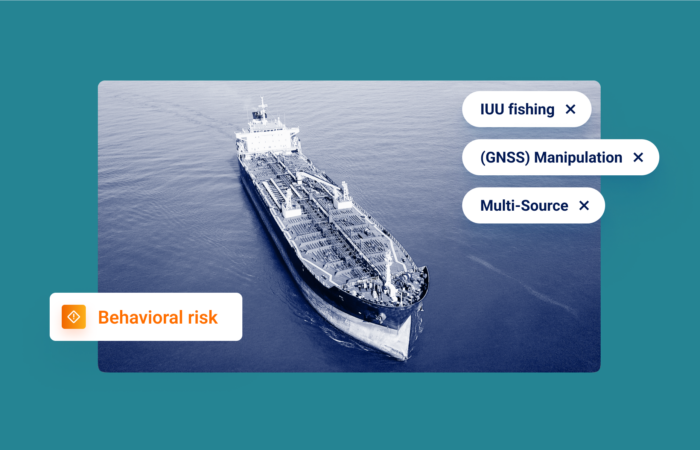What’s inside?
Maritime outlets briefly covered the recent three-ton cocaine bust off the Western Sahara coast earlier this week. A cargo vessel was intercepted and seized by a joint police, civil guard, and customs team on January 18 off the Western Sahara coast, and taken to Santa Cruz de Tenerife, on suspicion of drug trafficking.
By looking at this vessel’s history, there are lessons that coast guards, law enforcement, and defense and intelligence agencies can take to proactively identify future risks.
Windward’s Maritime AITM platform has data and risk insights on the Blume (IMO 8649993), the 97-meter cargo vessel, going all the way back to 2013. While the relevant authorities found the vessel suspicious because it was transporting far below its maximum cargo-hold capacity, Windward’s AI models identified and flagged this vessel as “high risk” for potential smuggling a few weeks before the bust, based on its illicit behavior and engagement in deceptive shipping practices. These included:
- A blacklisted flag (Togo)
- Multiple identity changes
- First-time visits
- Irregular business structure
- Multiple ownership changes
- Unusual loitering

Years of deception
The Blume didn’t start its illicit behavior recently. Windward’s models have flagged this vessel since it was originally designated as part of the sanctioned targets list by the UN Panel of Experts in early 2015 for numerous factors, including the usage of false foreign flags and collaborating with North Korea.

The ship again drew attention to itself in 2022, after Windward’s platform identified a first-time visit to Europe and the Black Sea, with our Russia Risk model flagging its port calls in Russia. The vessel was operating under a different identity compared to its identity following the UN designation.
Neither association was covered in the articles following the arrests. The Windward Maritime AI™ platform was able to track this vessel since its engagement with North Korea and through its numerous identity spoofing attempts.
A more in-depth look at the Blume’s recent actions will help government and law enforcement bodies better understand which type of actions they should be tracking closely, and which type of system best monitors those types of behaviors.
Suspicious behavior in the past few months
The vessel recently left East Asian waters for the first time in over a decade and traveled to South America. First-time visits are often an important indicator of deceptive shipping practices (DSPs). Most vessels have a specific routine and economic purpose, and deviations are unusual.

In the case of the Blume, further investigation with an effective maritime solution would reveal multiple identity changes. Our system logged 8 MMSI changes since 2014.

The Blume engaged in its first ever port call at Paranagua, Brazil, from October 19-November 10, 2022. It then made a port call at Santos, a known drug hub and exit point from South America, from November 10-December 21. Both of these port calls were extremely long and anomalous – why?
Cargo ships are designed to generate income, which they do by remaining mobile and active (although some wait around during the process of spot chartering). Staying stationary for such a long period of time can be a reliable warning sign of other goals/interests. The Blume previously operated an efficient port-to-port line in the Far East, so it was noteworthy to see it out of action for long periods.
The Blume next began its journey back towards West Africa, conducting numerous slow-speed activities along the route, until it arrived in the Morocco exclusive economic zone (EEZ) on January 15, 2023. It continued to conduct slow-speed activities within the EEZ. Again, similar to long port calls, this is strange behavior for a legitimate cargo ship. These types of vessels lose money when they are not expeditiously picking up and then offloading cargo.
Upon arriving at Laayoune (Western Sahara) on January 18, the vessel conducted a sharp westward course deviation, before going dark (disabling the AIS transmitter) on January 18 at 3:48 p.m. Sharp deviations are unusual for cargo vessels, as they plan out voyages in advance and attempt to map the most economical routes. And dark activities can of course be a prelude to illegal behaviors, such as drug smuggling.

Predictive analytics for prioritization & other lessons
Suspicious associations. First-time visits. Identity changes. Long port calls. Slow-speed activities. Sharp deviations. Going dark. These activities are some of the main activities that coast guards, law enforcement, and defense and intelligence agencies should be monitoring. Each activity by itself can be suspicious, but when strung together, they tell quite a story.
The truth is, it’s not necessary to actively search for these behaviors. In fact, it’s likely a waste of time. A good predictive analytics solution will automatically put the elements of “the story” together, which can help optimize resources and make smarter operational decisions. For instance, knowing which specific vessels to detain at the borders increases efficiency and ROI.
Speaking of manual versus automatic solutions (or even automatic maritime solutions that do not utilize predictive analytics vs. AI solutions), most solutions do not offer the identify resolution capabilities to track the Blume across 8 changes in nine years!
Also, this incident highlights how maritime risks are merging. The Blume started as a compliance related-risk, but eventually began engaging in drug smuggling. It also had over 70 Port State Control deficiencies, strengthening the notion that vessels that disregard safety requirements will often just as easily disregard regulations and maritime laws. Maritime domain visibility comes from understanding, identifying, and being able to track a wide variety of risks.
The Blume, which was loaded with cocaine, reminds us that if we know the signs and utilize the right technology, suspicious vessels can be located right under our noses…
Special thanks to Matan Makleff, Solutions Expert Manager at Windward, for the great information and investigative details he provided for this blog post.


